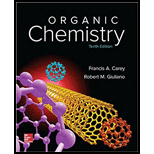
ORGANIC CHEMISTRY (LOOSELEAF)-PACKAGE
10th Edition
ISBN: 9781260008562
Author: Carey
Publisher: MCG
expand_more
expand_more
format_list_bulleted
Concept explainers
Question
Chapter 11, Problem 44P
Interpretation Introduction
Interpretation:
The Diels Alder adducts are to be identified.
Concept introduction:
>The conjugate addition of
Dienophile is the alkene that adds to diene.Diene is an electron-rich system that attacksan electron deficient dienophile.
>For retro Diels–-Alder, diene, and dienophile can be identified from the target molecule.
>If the target molecule has a cyclohexane ring, identify the double bond that can disconnect in a way to form
Expert Solution & Answer
Want to see the full answer?
Check out a sample textbook solution
Students have asked these similar questions
Based on the given information, determine the diene and dienophile of the Diels-Alder reaction.
Why does the diels alder reaction often show high selectivity and predictable stereochemistry?
Predict the product of the following Diels-Alder reaction. Make sure to indicate stereochemistry whereverapplicable.
Chapter 11 Solutions
ORGANIC CHEMISTRY (LOOSELEAF)-PACKAGE
Ch. 11.1 - Prob. 1PCh. 11.1 - Prob. 2PCh. 11.2 - The two compounds shown differ by a factor of 60...Ch. 11.2 - Prob. 4PCh. 11.2 - Prob. 5PCh. 11.2 - Prob. 6PCh. 11.3 - Prob. 7PCh. 11.3 - Prob. 8PCh. 11.3 - Evaluate 2,3,3-trimethyl-1-butene as a candidate...Ch. 11.4 - After heating a solution of allyl tert-butyl...
Ch. 11.5 - Prob. 11PCh. 11.6 - Prob. 12PCh. 11.8 - Prob. 13PCh. 11.9 - What dienes containing isolated double bonds are...Ch. 11.10 - Prob. 15PCh. 11.10 - Prob. 16PCh. 11.11 - Prob. 17PCh. 11.12 - Dicarbonyl compounds such as quinones are reactive...Ch. 11.12 - 2,3-Di-tert-butyl-1,3-butadiene is extremely...Ch. 11.12 - Methyl acrylate (H2C=CHCO2CH3) reacts with...Ch. 11.13 - Prob. 21PCh. 11.14 - What diene and dienophile could you use to prepare...Ch. 11.14 - Write equations in the synthetic direction for the...Ch. 11.16 - Prob. 24PCh. 11.16 - Prob. 25PCh. 11 - Write structural formulas for each of the...Ch. 11 - Give an acceptable IUPAC name for each of the...Ch. 11 - A certain species of grasshopper secretes an...Ch. 11 - Which of the following are chiral?...Ch. 11 - Describe the molecular geometry expected for...Ch. 11 - Prob. 31PCh. 11 - What compound of molecular formula C6H10 gives...Ch. 11 - Prob. 33PCh. 11 - Prob. 34PCh. 11 - Prob. 35PCh. 11 - Prob. 36PCh. 11 - Identify the more reactive dienophile in each of...Ch. 11 - Prob. 38PCh. 11 - Prob. 39PCh. 11 - Prob. 40PCh. 11 - Prob. 41PCh. 11 - Prob. 42PCh. 11 - Prob. 43PCh. 11 - Prob. 44PCh. 11 - Prob. 45PCh. 11 - Prob. 46PCh. 11 - Show how to prepare each of the following...Ch. 11 - Prob. 48PCh. 11 - Prob. 49PCh. 11 - Prob. 50PCh. 11 - Compound A was converted to compound B by the...Ch. 11 - Suggest reasonable explanations for each of the...Ch. 11 - Prob. 53PCh. 11 - Prob. 54PCh. 11 - Prob. 55DSPCh. 11 - Prob. 56DSPCh. 11 - Prob. 57DSPCh. 11 - Prob. 58DSPCh. 11 - Prob. 59DSP
Knowledge Booster
Learn more about
Need a deep-dive on the concept behind this application? Look no further. Learn more about this topic, chemistry and related others by exploring similar questions and additional content below.Similar questions
- in a diels-alder reaction involving 2,3-dimethyl-1,3-butadiene and maleic anhydride, which is the diene and which is the dienophile?arrow_forwardHow would the molecular orbitals of cyclopenta-1,3-diene, the carbocation, carbanion, and the radical differ? Drawings would be appreciated! Thank you in advance.arrow_forwardPredict the product of the following Diels-Alder reactions C and Darrow_forward
- Dimethyl azodicarboxylate takes part in a DielsAlder reaction as a dienophile. Write the structure of the cycloaddition product of this molecule with 1,2-dimethylenecyclohexane. Knowing that this compound is formed under mild conditions, explain what favors reactivity in a Diels-Alder reaction over diene and dienophile structures.arrow_forwardZingiberene and β-sesquiphellandrene, natural products obtained from ginger root, contain conjugated diene units. Which diene reacts faster in the Diels–Alder reaction and why?arrow_forwardPredict products of each Diels-Alder reaction (including stereochemistry)arrow_forward
- Of the three 1,4-diphenyl-1,3-butadiene isomers (E,E or E,Z or Z,Z) indicate the most suitable diene that can be used as a reactant in a Diels-Alder reaction. Explain your choice.arrow_forwardThe Diels–Alder reaction between butadiene and dimethyl maleate yields a ring structure, as shown in the product. Complete the structure by drawing any missing bonds and indicating the stereochemistry of the new stereocenters.arrow_forwardA chemist is attempting to synthesize a complex natural product with a highly strained cyclohexene ring system. Which type of reactants would be most suitable for achieving this goal, and why? Provide a detailed explanation of the choice of reactants and the expected outcome in terms of the Diels-Alder reaction.arrow_forward
- A2 What is the inverse electron demand Diels–Alder reaction? Please pick a pair of a diene and a dienophile from the following dienes and dienophile that will undergo this type of reaction. Please show how this reaction works using Frontier Molecular Orbitals. What is the reaction product?arrow_forwardWhich diene and dienophile would react to give the following Diels-Alder product?arrow_forwardRank the following dienes in order of increasing reactivity in a Diels–Alder reaction.arrow_forward
arrow_back_ios
arrow_forward_ios
Recommended textbooks for you
 Organic ChemistryChemistryISBN:9781305580350Author:William H. Brown, Brent L. Iverson, Eric Anslyn, Christopher S. FootePublisher:Cengage Learning
Organic ChemistryChemistryISBN:9781305580350Author:William H. Brown, Brent L. Iverson, Eric Anslyn, Christopher S. FootePublisher:Cengage Learning

Organic Chemistry
Chemistry
ISBN:9781305580350
Author:William H. Brown, Brent L. Iverson, Eric Anslyn, Christopher S. Foote
Publisher:Cengage Learning
